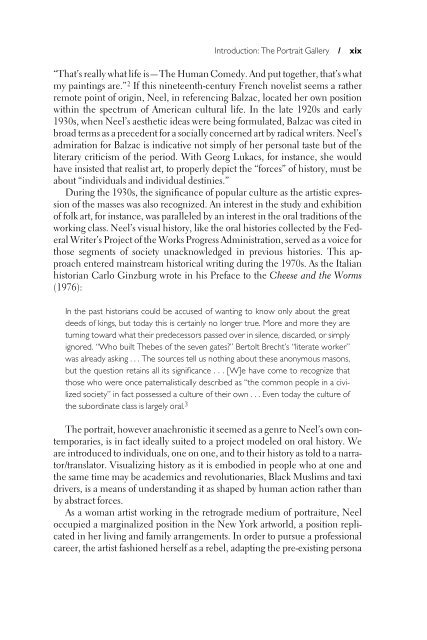i-xxii Front matter.qxd - Brandeis Institutional Repository
i-xxii Front matter.qxd - Brandeis Institutional Repository
i-xxii Front matter.qxd - Brandeis Institutional Repository
Create successful ePaper yourself
Turn your PDF publications into a flip-book with our unique Google optimized e-Paper software.
Introduction: The Portrait Gallery / xix“That’s really what life is—The Human Comedy. And put together, that’s whatmy paintings are.” 2 If this nineteenth-century French novelist seems a ratherremote point of origin, Neel, in referencing Balzac, located her own positionwithin the spectrum of American cultural life. In the late 1920s and early1930s, when Neel’s aesthetic ideas were being formulated, Balzac was cited inbroad terms as a precedent for a socially concerned art by radical writers. Neel’sadmiration for Balzac is indicative not simply of her personal taste but of theliterary criticism of the period. With Georg Lukacs, for instance, she wouldhave insisted that realist art, to properly depict the “forces” of history, must beabout “individuals and individual destinies.”During the 1930s, the signiƒcance of popular culture as the artistic expressionof the masses was also recognized. An interest in the study and exhibitionof folk art, for instance, was paralleled by an interest in the oral traditions of theworking class. Neel’s visual history, like the oral histories collected by the FederalWriter’s Project of the Works Progress Administration, served as a voice forthose segments of society unacknowledged in previous histories. This approachentered mainstream historical writing during the 1970s. As the Italianhistorian Carlo Ginzburg wrote in his Preface to the Cheese and the Worms(1976):In the past historians could be accused of wanting to know only about the greatdeeds of kings, but today this is certainly no longer true. More and more they areturning toward what their predecessors passed over in silence, discarded, or simplyignored. “Who built Thebes of the seven gates?” Bertolt Brecht’s “literate worker”was already asking . . . The sources tell us nothing about these anonymous masons,but the question retains all its signiƒcance . . . [W]e have come to recognize thatthose who were once paternalistically described as “the common people in a civilizedsociety” in fact possessed a culture of their own . . . Even today the culture ofthe subordinate class is largely oral. 3The portrait, however anachronistic it seemed as a genre to Neel’s own contemporaries,is in fact ideally suited to a project modeled on oral history. Weare introduced to individuals, one on one, and to their history as told to a narrator/translator.Visualizing history as it is embodied in people who at one andthe same time may be academics and revolutionaries, Black Muslims and taxidrivers, is a means of understanding it as shaped by human action rather thanby abstract forces.As a woman artist working in the retrograde medium of portraiture, Neeloccupied a marginalized position in the New York artworld, a position replicatedin her living and family arrangements. In order to pursue a professionalcareer, the artist fashioned herself as a rebel, adapting the pre-existing persona
















